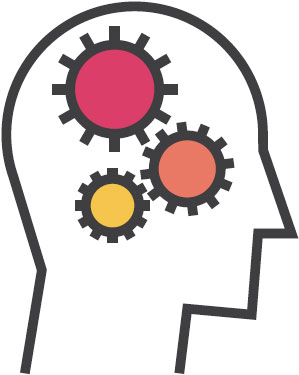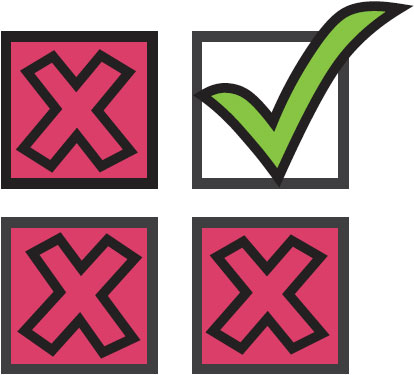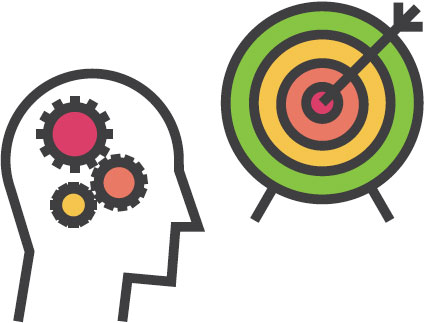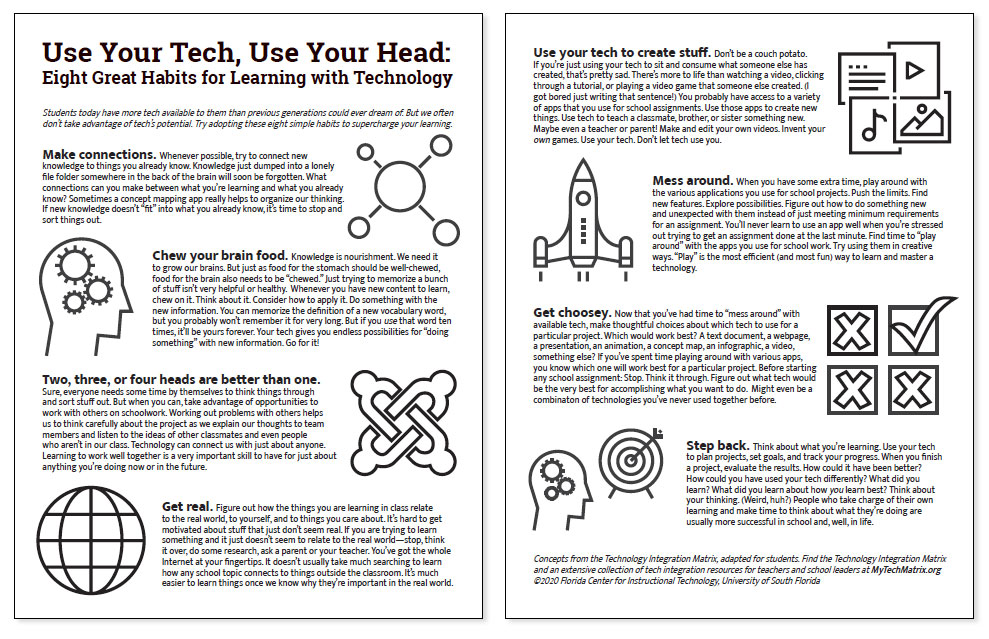As I write this, we are currently in the midst of The Great, Worldwide Experiment in Online Education of 2020. Never before has there been so obviously a need for students to be able to use their technology in ways that follow sound pedagogical principles. Students who are self-directed, active learners and can leverage available technology for learning are doing great. Millions of others are spending their days at home filling in endless online worksheets (at best).
In this unexpected situation, we have come to realize that our efforts to have teachers and school leaders adopt the Technology Integration Matrix principles are not enough. With so many students working independently from home, we also wanted to find a way to encourage students to follow the effective pedagogical strategies that underlie the TIM. Throwing the TIM with 25 cells and 100 descriptors at the average student wouldn’t accomplish much, so we attempted to distill the TIM down to eight habits that students could readily understand and implement.
We’ve created a two-page PDF for students to help them use technology more effectively in this time at home (and when face-to-face classes resume). Schools or districts may distribute this PDF to students, post it on their websites, and use it in classrooms and PD sessions. Scroll down for the PDF links. We welcome comments and suggestions about our first effort to present the TIM concepts to students.

Students today have more tech available to them than previous generations could ever dream of. But we often don’t take advantage of tech’s potential. Try adopting these eight simple habits to supercharge your learning.
Make connections. Whenever possible, try to connect new knowledge to things you already know. Knowledge just dumped into a lonely file folder somewhere in the back of the brain will soon be forgotten. What connections can you make between what you’re learning and what you already know? Sometimes a concept mapping app really helps to organize our thinking. If new knowledge doesn’t “fit” into what you already know, it’s time to stop and sort things out.


Chew your brain food. Knowledge is nourishment. We need it to grow our brains. But just as food for the stomach should be well-chewed, food for the brain also needs to be “chewed.” Just trying to memorize a bunch of stuff isn’t very helpful or healthy. Whenever you have new content to learn, chew on it. Think about it. Consider how to apply it. Do something with the new information. You can memorize the definition of a new vocabulary word, but you probably won’t remember it for very long. But if you use that word ten times, it’ll be yours forever. Your tech gives you endless possibilities for “doing something” with new information. Go for it!
Two, three, or four heads are better than one. Sure, everyone needs some time by themselves to think things through and sort stuff out. But when you can, take advantage of opportunities to work with others on schoolwork. Working out problems with others helps us to think carefully about the project as we explain our thoughts to team members and listen to the ideas of other classmates and even people who aren’t in our class. Technology can connect us with just about anyone. Learning to work well together is a very important skill to have for just about anything you’re doing now or in the future.


Get real. Figure out how the things you are learning in class relate to the real world, to yourself, and to things you care about. It’s hard to get motivated about stuff that just doesn’t seem real. If you are trying to learn something and it just doesn’t seem to relate to the real world—stop, think it over, do some research, ask a parent or your teacher. You’ve got the whole Internet at your fingertips. It doesn’t usually take much searching to learn how any school topic connects to things outside the classroom. It’s much easier to learn things once we know why they’re important in the real world.
Use your tech to create stuff. Don’t be a couch potato. If you’re just using your tech to sit and consume what someone else has created, that’s pretty sad. There’s more to life than watching a video, clicking through a tutorial, or playing a video game that someone else created. (I got bored just writing that sentence!) You probably have access to a variety of apps that you use for school assignments. Use those apps to create new things. Use tech to teach a classmate, brother, or sister something new. Maybe even a teacher or parent! Make and edit your own videos. Invent your own games. Use your tech. Don’t let tech use you.


Mess around. When you have some extra time, play around with the various applications you use for school projects. Push the limits. Find new features. Explore possibilities. Figure out how to do something new and unexpected with them instead of just meeting minimum requirements for an assignment. You’ll never learn to use an app well when you’re stressed out trying to get an assignment done at the last minute. Find time to “play around” with the apps you use for school work. Try using them in creative ways. “Play” is the most efficient (and most fun) way to learn and master a technology.
Get choosey. Now that you’ve had time to “mess around” with available tech, make thoughtful choices about which tech to use for a particular project. Which would work best? A text document, a webpage, a presentation, an animation, a concept map, an infographic, a video, something else? If you’ve spent time playing around with various apps, you’ll know which one will work best for a particular project. Before starting any school assignment: Stop. Think it through. Figure out what tech would be the very best for accomplishing what you want to do. It might even be a combinaton of technologies you’ve never used together before.


Step back. Think about what you’re learning. Use your tech to plan projects, set goals, and track your progress. When you finish a project, evaluate the results. How could it have been better? How could you have used your tech differently? What did you learn? What did you learn about how you learn best? Think about your thinking. (Weird, huh?) People who take charge of their own learning and make time to think about what they’re doing are usually way more successful in school and, well, in life.
Download Color PDF
2 pages, 376 KB. PDF may be distributed to students, used in classrooms, or posted to school or district websites.
Download Black & White PDF
2 pages, 377 KB. PDF may be distributed to students, used in classrooms, or posted to school or district websites.
Roy Winkelman is a 40+ year veteran teacher of students from every level kindergarten through graduate school. As the former Director of FCIT, he began the Center's focus on providing students with rich content collections from which to build their understanding. When not glued to his keyboard, Dr. Winkelman can usually be found puttering around his tomato garden in Pittsburgh.


